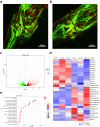Chromosome-level genome assembly of Zizania latifolia provides insights into its seed shattering and phytocassane biosynthesis
- PMID: 35017643
- PMCID: PMC8752815
- DOI: 10.1038/s42003-021-02993-3
Chromosome-level genome assembly of Zizania latifolia provides insights into its seed shattering and phytocassane biosynthesis
Abstract
Chinese wild rice (Zizania latifolia; family: Gramineae) is a valuable medicinal homologous grain in East and Southeast Asia. Here, using Nanopore sequencing and Hi-C scaffolding, we generated a 547.38 Mb chromosome-level genome assembly comprising 332 contigs and 164 scaffolds (contig N50 = 4.48 Mb; scaffold N50 = 32.79 Mb). The genome harbors 38,852 genes, with 52.89% of the genome comprising repetitive sequences. Phylogenetic analyses revealed close relation of Z. latifolia to Leersia perrieri and Oryza species, with a divergence time of 19.7-31.0 million years. Collinearity and transcriptome analyses revealed candidate genes related to seed shattering, providing basic information on abscission layer formation and degradation in Z. latifolia. Moreover, two genomic blocks in the Z. latifolia genome showed good synteny with the rice phytocassane biosynthetic gene cluster. The updated genome will support future studies on the genetic improvement of Chinese wild rice and comparative analyses between Z. latifolia and other plants.
© 2022. The Author(s).
Conflict of interest statement
The authors declare no competing interests.
Figures





References
-
- Yan N, et al. A comparative UHPLC-QqQ-MS-based metabolomics approach for evaluating Chinese and North American wild rice. Food Chem. 2019;275:618–627. - PubMed
-
- Yu X, et al. Wild rice (Zizania spp.): A review of its nutritional constituents, phytochemicals, antioxidant activities, and health-promoting effects. Food Chem. 2020;331:127293. - PubMed
-
- Zhai CK, Tang WL, Jang XL, Lorenz KJ. Studies of the safety of Chinese wild rice. Food Chem. Toxicol. 1996;34:347–352. - PubMed
Publication types
MeSH terms
Grants and funding
- 1610232018003/Chinese Academy of Agricultural Sciences (CAAS)
- 1610232020008/Chinese Academy of Agricultural Sciences (CAAS)
- 1610232021006/Chinese Academy of Agricultural Sciences (CAAS)
- ASTIP-TRIC05/Chinese Academy of Agricultural Sciences (CAAS)
- ASTIP-TRIC05/Chinese Academy of Agricultural Sciences (CAAS)
LinkOut - more resources
Full Text Sources
Miscellaneous

